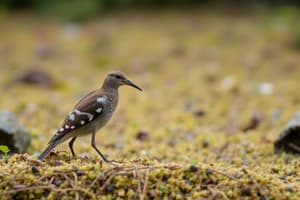Podcast
Questions and Answers
What is the primary focus of conservation biology and how does it aim to preserve biodiversity and ecosystem health?
What is the primary focus of conservation biology and how does it aim to preserve biodiversity and ecosystem health?
Conservation biology focuses on preserving biodiversity and the health of ecosystems. It employs various strategies, including habitat protection, population monitoring, and invasive species control, to safeguard the existence of thousands of plant and animal species and ensure the survival of the ecosystem itself.
Explain the importance of biodiversity in maintaining ecosystem stability and supporting human economies. Provide specific examples of essential ecosystem services that biodiversity provides.
Explain the importance of biodiversity in maintaining ecosystem stability and supporting human economies. Provide specific examples of essential ecosystem services that biodiversity provides.
Biodiversity is vital for maintaining ecosystem stability, supporting human economies, and providing essential ecosystem services, such as clean air, water, and soil fertility. By conserving ecosystems, we can safeguard the existence of thousands of plant and animal species, ensuring the survival of the ecosystem itself and the essential services it provides to human societies.
Describe the role of restoration ecology in conservation biology and explain why it is important to restore damaged ecosystems.
Describe the role of restoration ecology in conservation biology and explain why it is important to restore damaged ecosystems.
Conservation biology recognizes the importance of restoring damaged ecosystems, such as those impacted by pollution or overexploitation of resources. Restoring these ecosystems is crucial to maintaining biodiversity and the health of the overall environment.
How does the concept of ecosystem diversity differ from biodiversity, and what is the significance of each in the context of environmental biology?
How does the concept of ecosystem diversity differ from biodiversity, and what is the significance of each in the context of environmental biology?
Explain how the interconnected nature of ecosystems, biodiversity, and conservation biology enables the development of sustainable practices and informed decisions regarding the stewardship of Earth's resources.
Explain how the interconnected nature of ecosystems, biodiversity, and conservation biology enables the development of sustainable practices and informed decisions regarding the stewardship of Earth's resources.
Explain how the disruption of an ecosystem's equilibrium can lead to cascading effects on its biotic and abiotic components, and provide a specific example.
Explain how the disruption of an ecosystem's equilibrium can lead to cascading effects on its biotic and abiotic components, and provide a specific example.
Describe the relationship between genetic diversity within a species and the species' ability to adapt to environmental changes. Provide an example illustrating this concept.
Describe the relationship between genetic diversity within a species and the species' ability to adapt to environmental changes. Provide an example illustrating this concept.
Discuss the potential consequences of losing a keystone species in an ecosystem, and explain the concept of trophic cascades with a relevant example.
Discuss the potential consequences of losing a keystone species in an ecosystem, and explain the concept of trophic cascades with a relevant example.
Explain the concept of ecosystem services and provide examples of how biodiversity contributes to the provision of these services.
Explain the concept of ecosystem services and provide examples of how biodiversity contributes to the provision of these services.
Discuss the challenges and strategies involved in conserving biodiversity in the face of human activities such as habitat fragmentation, pollution, and climate change.
Discuss the challenges and strategies involved in conserving biodiversity in the face of human activities such as habitat fragmentation, pollution, and climate change.
Study Notes
Environmental Biology: Ecosystems, Biodiversity, and Conservation Biology
Introduction
Environmental biology is the scientific discipline that investigates relationships between living organisms and their environment. This interdisciplinary field encompasses various subtopics, including ecosystems, biodiversity, and conservation biology. These topics are crucial for understanding the complex interactions between species and their surroundings, and for developing strategies to preserve Earth's diverse ecosystems and the myriad of life forms they contain.
Ecosystems
An ecosystem consists of living organisms, known as biotic factors, and non-living elements, called abiotic factors. These components interact with one another in a dynamic equilibrium, forming a unique and self-sustaining community. Ecosystems vary in size, ranging from a single tree hole harboring insects to vast tracts of rainforests teeming with diverse flora and fauna. Understanding ecosystems helps us appreciate the delicate balance between various ecological components and the consequences of disrupting this harmony.
Biodiversity
Biodiversity is the variety of life found on Earth, encompassing genetic diversity within species, the variety of different species, and the variation in ecosystems. Genetic diversity refers to the differences in DNA sequences among individuals within a species, whereas species diversity reflects the number of distinct species present. Ecosystem diversity refers to the variety of habitats and the ecological processes that occur within them. Biodiversity is vital for maintaining ecosystem stability, supporting human economies, and providing essential ecosystem services, such as clean air, water, and soil fertility.
Conservation Biology
Conservation biology focuses on preserving biodiversity and the health of ecosystems. This field employs various strategies, including habitat protection, population monitoring, and invasive species control. By conserving ecosystems, we can safeguard the existence of thousands of plant and animal species, ensuring the survival of the ecosystem itself. Additionally, conservation biology recognizes the importance of restoring damaged ecosystems, such as those impacted by pollution or overexploitation of resources.
In conclusion, environmental biology encompasses a broader perspective that includes the study of ecosystems, biodiversity, and conservation biology. Understanding these interconnected topics enables us to develop sustainable practices and informed decisions regarding the future stewardship of our planet's living and non-living resources.
Studying That Suits You
Use AI to generate personalized quizzes and flashcards to suit your learning preferences.
Description
Test your knowledge on the intricate relationships between living organisms and their environment, including ecosystems, biodiversity, and conservation biology. Explore key concepts essential for preserving Earth's diverse ecosystems and the myriad of life forms they support.




